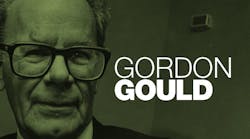From the moment that Gordon Gould first conceived of the laser (light amplification by stimulated emission of radiation), he knew his invention would have a lasting effect on every aspect of the world around him. The realization was so great that the young physicist worked feverishly for three days to document his ideas, which would eventually become the source of one of the longest and most bitter patent lawsuits in American history.
"When the coffee was made, Gould poured a cup and went into his study. He sat down and thought it through to be sure he wasn't making a mistake. He wasn't," wrote Nick Taylor, author of LASER: The Inventor, The Nobel Laureate, And The Thirty-Year Patent War.
"His mind raced as the dimensions of the breakthrough continued to reveal themselves. He could achieve, in an instant, temperatures hotter than the sun. He could cut holes in steel, cause chemical reactions, perhaps trigger nuclear reactions," Taylor explained.
"He could communicate over enormous distances. After several minutes, he opened a lined laboratory notebook, the kind you could buy in any college bookstore, and started to write. His fountain pen scratched the cheap paper as he wrote in a neat, right-slanting hand, 'Some rough calculations on the feasibility of a LASER.'"1
Dodging the bullet
Gordon Gould was born in New York City in 1920. He was 21 years old when he graduated from New York's Union College in 1941 with a degree in physics. By the end of the next academic year, he had earned a master's in optics and spectroscopy as well.
Gould, eager to receive his PhD, dove right into doctorate studies at Yale. He managed to continue his education during World War II by serving as an instructor to young scientists involved in the war effort. But then, in 1943, he was drafted.
Recognizing Gould's potential, the head of the physics department at Yale decided that something needed to be done to stop the young physicist from being sent into battle. He suggested that Gould apply for an assignment on the Manhattan Project. Gould's stint with the project, though, didn't last long. Less than a year after he joined the more than 100,000 scientists working on the effort, he was dismissed due to his ties with the Communist Party.2
In 1946, Gould started teaching physics classes at the City College of New York. But while he was busy educating others, he had little time to educate himself. So in 1949 he returned to his studies in optics, enrolling at Columbia University. It was there that he would meet Charles Townes, the man who invented the maser (microwave amplification by stimulated emission of radiation). Townes also eventually would be credited for years for the invention of—and the rights to—the laser.
Exploited
Gould first met Townes at the 1956 Molecular Beams Conference at Brookhaven National Laboratory in Long Island, N.Y. The former chair of Columbia's physics department, Townes had achieved celebrity status in the scientific community for the maser, among other innovations. He reacted with great interest when Gould came to him with an idea to incorporate optical pumping with the maser. He invited Gould to lecture on his theory to a group of physics students at Columbia, an invitation that Gould readily accepted.
A novice when it came to documenting intellectual property, Gould repeatedly sought Townes' advice on obtaining a patent. Townes, who himself was working on the idea that visible light could be focused into a beam under the right conditions, told Gould he should record all of his notes in a notebook and get it notarized. He even volunteered to serve as a witness to Gould's documentation. More than 30 years later, when Gould was finally awarded the patents for his light-excited maser, the courts would question whether Townes had stolen ideas from him to obtain a patent that he later used to license laser manufacturers.
In November 1957, Gould took a notebook containing his concept of a single concentrated beam of light created by two mirrors in a gas-filled chamber down to a local candy store to be notarized—what he believed to be the first step toward patenting the laser. But it wasn't until 1959 that he officially filed an application for a patent. By that time, it was too late. Townes and another physicist, Arthur Schawlow, had filed their own patent applications.
Victory, at last
For almost three decades, Gould watched as manufacturers around the world exploited the technology that "struck Gould with the force of a revelation."1 But Gould, backed by his employer, TRG, battled the courts for years until October 1977, when the U.S. Patent Office finally awarded him a patent on the optical pumping of lasers. In the end, all four of the patent applications Gould filed decades earlier were granted.
By April 1988, when Gould's use patent was approved, optically pumped amplifier patents covered 80% of the lasers made in the United States. The market for lasers had ballooned to more than $500 million per year. Suddenly, Gould was a multimillionaire.1
Gordon Gould died on September 16, 2005. His patent wars continue to inspire debate today about patent law.
References
- Taylor, N. LASER: The Inventor, The Nobel Laureate, And The Thirty-Year Patent War
- en.wikipedia.org, Gordon Gould, en.wikipedia.org/wiki/Gordon_Gould
